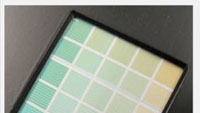Philips electrophoretics technology may replace LCD video monitors

About a decade ago, at a news conference in New York, Adobe demonstrated a flat-panel color display showing the front page of the “New York Times.” It looked like a regular newspaper, until one touched a picture on the front page. The picture became animated, and the photo instantly turned to moving video.
It was an eye-opening moment, full of future possibilities. However, Adobe was only conducting a technology demonstration. The product wasn't real then, nor would it be in the near future. While the nation's newspapers desperately need such a color device today to rejuvenate their declining fortunes, the best available are monochrome book readers like Amazon's Kindle or Sony's Reader.
However, Philips has demonstrated a new color technology that just might make Adobe's futuristic demo become reality. In fact, the technology is so promising that it could even be used to replace the LCD television monitors that now dominate the video market.
Philips, based in Amsterdam, has discovered a new technology called in-plane electrophoretics. Unlike current technologies, it moves colored particles throughout a clear liquid horizontally across a display screen.
Each pixel is constituted of two microcapsule chambers: one containing yellow and cyan particles, the other containing magenta and black particles. Within each microcapsule, one set of colored particles is charged positively while the other is charged negatively.
By controlling the voltages with electrodes positioned on the edges of the pixels, Philips can spread the colored particles across the pixel or hide them completely behind the electrodes.
Different shades of color can be achieved by controlling how many of each group of colored particles are visible. To create white, for example, all of the particles are shifted to the side to reveal the white substrate beneath the two microcapsules.
The professional video industry's #1 source for news, trends and product and tech information. Sign up below.
The Philips technology is very bright and clear. It’s three times brighter than color devices that use color filters, including today's LCD monitors. And, because the electronics is simpler and cheaper to make, prices could be lower than today's technologies.
The current E-Ink technology in devices like the Kindle or Reader use electrophoresis technology. Here each pixel consists of a microcapsule filled with a black oily liquid within which very small white particles are suspended. These particles are charged. When an electric field is passed through the particles, they move vertically up to the top of surface of the page, creating the print for the document being read.
Current color display technology, also used in LCD monitors, usually requires filters — four subpixels made up of red, green, blue and white — to create each full-color pixel. The trade-offs with the filter technology are resolution and brightness.
Philips’ in-plane electrophoretics technology is three years away from being ready to manufacture. Filtered color e-paper will hit the market first, the company predicted, though it’s more complex to manufacture. Because such filters are already used in LCDs, its cost will be temporarily lower.
However, in-plane electrophoretics relies on simpler, lower cost electronics to address the pixels, Philips said. It also can be used in flexible, bendable displays. When the technology is ready for manufacture, this may offer significant advantages over filtered technologies.
